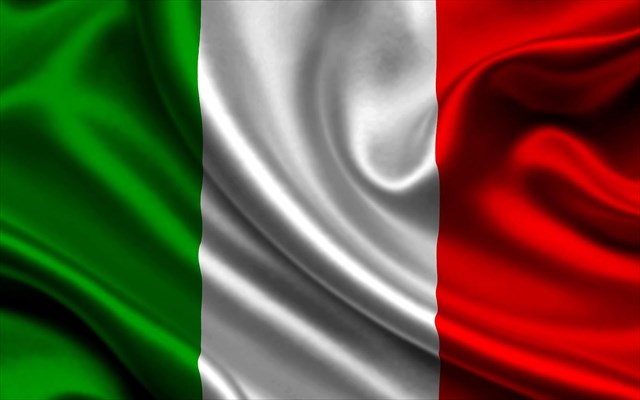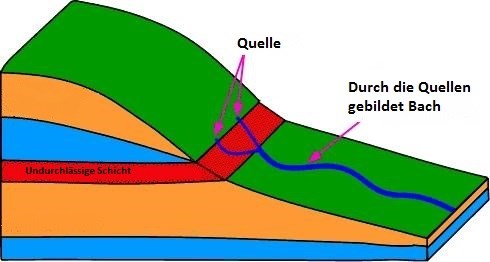
ENGLISH:
Route:
First take the cycle track from San Candido/Innichen towards Sesto/Sexten. Turn right towards the thermal springs.
Source (water):
A source or seepage is a place where water comes from the ground.
One distinguishes“point sources” and “diffuse sources”.
• A “point source” is a place where a clear water flow comes above the ground.
• In case of a “diffuse source”, there are multiple points where the water comes out of the ground. This is also known as seepage.
Bagni di San Candido is a diffuse source or seepage.Seepage is groundwater that comes to the surface through pressure. In general seepage is created by a subterranean flow of water from an upper area to a lower area. The size of the flow rate is modeled with Darcy's law, in which the permeability of the materials plays a role. Seepage can occur over distances of a few meters to several kilometers. Seepagewater forms sources such in Bagni di San Candido.
Beginning of a natural seepage:
The flow of the groundwater, the relief and the geomorphological structure of an area determine the beginning of a seepage. On the higher parts of the earth, the (rain) water sinks into the soil. Part of this water flows down as phreatic groundwater and thus comes directly into streams and lakes. The rest penetrates the poorly permeable layer and ends up in the first layer or deeper.

Seepage often has a specific water quality. Especially deep seepage which for centuries have flowed through the bottom, its oxygen and nutrient poor and often contains calcium, iron and minerals.
Mineral water:
Natural mineral water is water from an underground water resources, which has a special hygienic condition and has positive effects on human health. Mineral water is distinguished from drinking water through its natural purity, by its content of minerals and by the action of these ingredients. These properties should not change over time. Mineral water is the product of the rain water and rocks in the subsurface. Simplified, this means that ordinary rainwater by solution processes of rocks obtains a typical geology imprint for the particular underground. As South Tyrol is geologically very diverse, there are correspondingly different compositions underground waters, some of which have very special characteristics, such as the content of the radioactive element radon or unusual elements such as lithium, selenium and iodine.
In South Tyrol 32 mineral waters are recognized by decision of the provincial government. These sources have been selected from a long line that have been used in the past for Bauernbaths and sanatoriums or have been bottled as mineral water and sold.
Source: Wikipedia, Autonomous Province of Bozen Südtirol
The mission:
Answers to the questions below can be found on the information boards.
It would be nice if you take a picture of you at the “Bagni di San Candido” along with your log-entry (however this is not required for logging your visit).
1) How many sources are there visible on the site? What is their name?
2) Specify for each source for what disease they would be good.
3) How high starts the highest spring?
4) Which two brands of water are still bottled from these sources?
5) How many picnic tables are there in the fenced area?
Send your answers for the questions via eMail to: answer 3 – answer 5 = XXXX
bagniXXXX@gmail.com Logs without permission or containing wrong answers will be deleted.
--------------------------------------------------------------------------------------------------------------------------------------

ITALIANO:
Percorso:
Partendo da San Candido si segue il sentiero ciclistico in direzione Sesto, poi bisogna svoltare a destra in direzione Bagni di San Candido.
Fonte (acqua):
Una fonte se è un luogo dove l'acqua proviene dal terreno
Si distinguono fonti puntuali e fonti diffuse.
• Una fonte punto è un luogo in cui un flusso d'acqua chiara è sopra la terra.
• In caso di una fonte diffusa, ci sono più punti in cui l'acqua entra dal terreno. Questo è noto anche come infiltrazione.
Bagni di San Candido è una fonte diffusa o infiltrazioni. Acque sotterranee è venuta a galla dal suolo sotto pressione. In penombra generale creata da un flusso di acqua sotterranea da una zona superiore di una zona più bassa. La dimensione della portata è modellato con la legge di Darcy, in cui la permeabilità dei materiali gioca un ruolo. Infiltrazioni possono verificarsi su distanze di pochi metri a diversi chilometri. Infiltrazioni d'acqua è fonti come Bagni di San Candido.

Alzati da un infiltrazioni naturali:
Il flusso delle acque sotterranee, determinare il rilievo e la struttura geomorfologica di un'area, o vi è infiltrazione. Sulle parti superiori di campo lascia cadere acqua (pioggia) nel terreno. Una parte di questa acqua scorre via come freatica sotterranee e finisce direttamente nei fossi e pozzanghere fino. Il resto penetra lo strato poco permeabile e finisce in prima falda o più in profondità giustificata. Infiltrazioni ha spesso una qualità dell'acqua specifica. Particolarmente profonda infiltrazioni che per secoli hanno fluito attraverso il fondo, l'ossigeno e povere di nutrienti e spesso calcio e ferro e contengono sostanze minerali.
Acque minerali:
E' considerata acqua minerale naturale quella che avendo origine da una falda sotterranea ha caratteristiche igieniche particolari ed effetti positivi sulla salute umana. L'acqua minerale si distingue da quella potabile per la sua purezza all'origine, per il suo contenuto di minerali ed i loro effetti benefici. Queste caratteristiche debbono mantenersi costanti nel tempo.
L'acqua minerale é il prodotto delle precipitazioni dell'acqua sulla roccia e nel sottosuolo. Praticamente significa che la comune acqua piovana scorrendo attraverso fessurazioni nella roccia, dalla diversa natura geologica del sottosuolo, assume caratteristiche tipiche. La complessa geologia dell'Alto Adige comporta una corrispondente diversificazione delle acque sotterranee che assumono caratteristiche molto particolari come ad esempio il contenuto di elementi insoliti come litio, selenio, iodio o radioattivi come il radon.
La Giunta Provinciale ha riconosciuto come minerali le acque di 32 sorgenti. Esse sono state selezionate tra un gran numero di fonti utilizzate nel tempo nei bagni rustici locali, dove venivano eseguite cure idropiniche e bagni o giá imbottigliatee commercializzate.
Fonte: Wikipedia, Provincia Autonoma Di Bolzano Alto Adige
La missione:
Le risposte alle domande qui sotto si possono trovare sulle schede informative.
Ci farebbe inoltre molto piacere vedere le vostre foto al “Bagni di San Candido” allegate al vostro log (non è tuttavia obbligatorio per loggare la cache).
1) Quante fonti ci sono in quest´area e come si chiamano?
2) Specificate per ciascuna sorgente contro quale malattia aiuta!
3) Su quale altitudine nasce la fonte piú alta?
4) Quali 2 marche di acqua vengono imbottigliate da 2 di queste sorgenti?
5) Quanti tavoli da pic-nic ci sono nella zona recintata?
Invia le tue risposte alle domande via Email a: risposta 3 – risposta 5 = xxxx
bagnixxxx@gmail.com I log che non hanno ricevuto il permesso o che contengono le risposte sbagliate verranno cancellati.
--------------------------------------------------------------------------------------------------------------------------------------

GERMAN:
Tour:
Zunächst von Innichen über den Fahrradweg Richtung Sexten, rechts abbiegen zum Wildbad.
Quelle (wasser):
Eine Quelle ist ein Ort, an dem dauerhaft oder zeitweise Grundwasser auf natürliche Weise an der Geländeoberfläche austritt.
Man unterscheidet„Punktquellen“ und „diffusen Quellen“.
• Eine „Punktquelle“ ist ein Ort, an dem ein klarer Wasserstrom kommt über dem Boden.
• Im Falle einer „diffusen Quelle“, gibt es mehrere Punkte, an denen das Wasser in aus dem Boden. Dies wird auch als Versickerung bekannt.
Bagni di San Candido ist eine diffuse Quelle oder Versickerung. Eine Versickerung ist Grundwassers das auf die Oberfläche des Bodens unter Druck kommt. Schafft im allgemeinen eine Versickerung durch einen unterirdischenWasserstrom von einem oberen Bereich zu einem unteren Bereich. Die Größe der Durchflussrate wird mit Darcy-Gesetz, bei dem die Durchlässigkeit der Materialien eine Rolle spielt modelliert. Eine Versickerung Ort über Entfernungen von einigen Metern bis zu mehreren Kilometern erfolgen. Versickerungwasser Form Quellen wie Bagni di San Candido.

Schaffung einer natürlichen Versickerung:
Die Grundwasserströmung, bestimmen die Erleichterung und geomorphologischen Struktur einer Fläche, oder es ist Versickerung. Die höheren Teile eines Feldes fällt er (regen) das Wasser im Boden. Ein Teil dieses Wassers fließt als phreatic Grundwasser und landet direkt in Gräben und Pfützen auf. Der Rest dringt die schlecht durchlässige Schicht und endet in der ersten wasserführenden Schicht oder tiefer gerechtfertigt. Versickerung hat oft eine bestimmte Wasserqualität. Besonders tiefe Versickerung, die seit Jahrhunderten durch den Boden floss, dessen Sauerstoff und nährstoffarmen und oft Kalzium und Eisen und Mineralien enthalten.
Mineralwasser:
Natürliches Mineralwasser ist Wasser aus einem unterirdischen Wasservorkommen, das eine besondere hygienische Beschaffenheit besitzt und positive Auswirkungen auf die menschliche Gesundheit hat. Mineralwasser unterscheidet sich von Trinkwasser durch seine natürliche Reinheit, durch seinen Gehalt an Mineralstoffen und durch die Wirkung dieser Inhaltsstoffe. Diese Eigenschaften dürfen sich im Laufe der Zeit nicht ändern. Mineralwasser ist das Produkt aus Regenwasser und Gestein im Untergrund. Vereinfacht bedeutet dies, dass gewöhnliches Regenwasser durch Lösungsvorgänge der Gesteine im Untergrund eine für die jeweilige Geologie typische Prägung erhält. Da Südtirol geologisch sehr vielfältig ist, gibt es dementsprechend unterschiedlich zusammengesetzte unterirdische Wässer, von denen einige ganz besondere Eigenschaften aufweisen, wie z.B. den Gehalt an dem radioaktiven Element Radon oder an ungewöhnlichen Elementen wie Lithium, Selen und Jod.
In Südtirol sind 32 Mineralwässer mittels Beschluss der Landesregierung anerkannt. Diese Quellen wurden aus einer langen Reihe ausgesucht, die seit alters her für Bauernbäder und Heilanstalten genutzt wurden oder bereits als Mineralwasser abgefüllt und verkauft wurden.
Quelle: Wikipedia, Autonome Provinz Bozen SüdTirol
Die Aufgabe:
Die Antworten auf die nachstehenden Fragen finden Sie auf den Informationstafeln. Es wäre schön, wenn du ein Bild von dir am “Bagni di San Candido” einstellen würdest (dies ist allerdings keine Voraussetzung für das Loggen deines Besuches).
1) Wie viele Quellen gibt es in diesem Gebiet und wie heißen sie?
2) Geben Sie an, welche Quelle jeweils gegen welche Krankheiten hilft?
3) Wie hoch liegt die höchste dieser hier erwähnten Quellen?
4) Welche 2 Mineralwassersorten werden von 2 dieser Quellen abgefüllt?
5) Wie viele Picknicktische stehen im eingezäunten Bereich?
Schicke deine Antworten auf die Fragen an die Email-Adresse: Antwort 3 – Antwort 5 = XXXX
bagnixxxx@gmail.com Einträge ohne Freigabe oder mit falschen Antworten werden gelöscht.